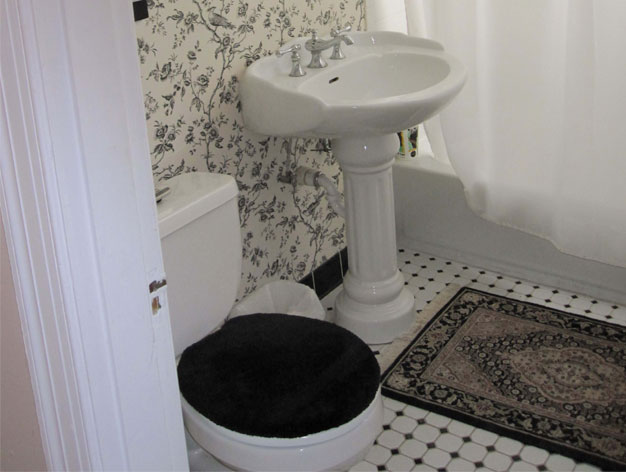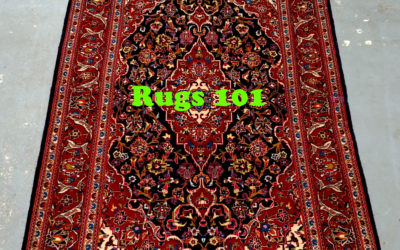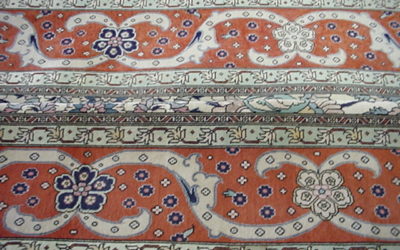
Yes, a Persian Bathroom Rug can Work in your Home!
If you’ve been googling, searching and pinning bathroom pics lately, you’ve probably noticed some new trends in salles de bains (this is fancy speak for bathroom in case you didn’t know). People are choosing Persians and other Orientals for their bathroom rug. Yes! It can be done. In fact, I’d like to toot my own horn and put it right out there that I, myself, yours truly, put a Persian bathroom rug in my first apartment, circa 2004. Now I’m not saying it definitively, but you could totally say that I started this trend, and I won’t argue with you. See that pic above? That’s my first apartment bathroom with an itty bitty Sino-Persian rug in it.
So, there are reasons why one might be hesitant to pick a Persian bathroom rug, and I’ll be the first to tell you that this isn’t for everybody, but it works for some, and I’ll help you to figure out if it will work for you. It probably bears worth mentioning that I lived with that itty bitty black and white bathroom for 6 years, and I showered regularly. Nothing happened to my rug. It also bears worth mentioning that I was the only person using that bathroom, my tub never leaked and I was careful. Actually, let’s strike that last part. I wasn’t consciously careful, I just wasn’t a hot mess…slight difference.
Water, Water, But is it Everywhere?
Really, the main reason why people don’t put rugs in bathrooms is fear of the water and its effects. And, they’re right. Water can cause damage to your rug, either quickly in a flood-like situation, or slowly in a dry-rot situation.
So, if you’re worried about a flood in your bathroom either because you do all your own shoddy plumbing work or because your toddler likes to flush matchbox cars down the toilet, let’s just say that a Persian bathroom rug isn’t for you. Why beat around the bush?
But, let’s say you’re relatively free and clear from the flood zone, is this a good idea for you? Well, if your bathroom is a powder room, I’d go ahead and say absolutely! Put that rug in there. Look at this designer who redid her powder room with the prettiest kelim ever:

As far as your regular 4-piece bath is concerned, proximity to the tub would be my next question when deciding whether or not to put a Persian rug in your bathroom. Is this rug going to be directly in front of your tub, like will you be stepping out damp and bare right onto that sucker? No? Okay, survey says: rug! Here is a bold Hamadan Persian bathroom rug used in front of a really gorgeous two-sink vanity. No tubs to be seen here:

So let’s say that your rug will, like mine, be in front of your tub where you step out of the shower. Do you still want to put a rug in your bathroom? Well, yes and no. Rugs that are consistently damp (not wet enough for you to notice, mind you, which is why it can be annoying) are susceptible to dry rot. Dry rot is a nasty issue where the rug becomes dry and brittle and then cracks and breaks because it was just a tad bit wet for much too long. This issue is almost never cost effective to repair, so bye bye rug. You can see this issue in rugs which have had potted plants on top of them, rugs that have been used directly on concrete floors and rugs in front of kitchen sinks where the plumbing has been leaking just a teeny tiny bit. If you tend to splash a lot in the tub and/or have several people showering in this bathroom a day, I might be inclined to say no just to be safe. All that dripping might create the perfect conditions to allow dry rot to occur. But, if you’re the only one using this shower, or you know in advance that you’re a careful one, then a rug isn’t a bad idea! It might look great, just like this:

Persian Bathroom Rug? Yes! But, What Kind?
Alrighty, so now that you’ve determined that you are good to go to have all this style in your bathroom, let’s decide what kind of rug to use. There are three main types of materials that go into handmade rugs: wool, cotton and silk. (Okay, there are more than three types, but those other types are really out there on the fringes – pun intended! – so we won’t bother with them.)
Silk rugs, okay, let’s just not use any 100% silk rugs in the bathroom. It is like tempting fate. My own rug in my bathroom had some very tiny silk highlights, and that was okay. I only tempted fate a teeny tiny bit.
Cotton rugs. Yes! Use these freely. No problems here.
Wool rugs. Yes, and No. Darn it, I knew this was going to get complicated. Most rugs consist of a wool pile knotted onto a foundation of cotton. Rugs that have this cotton foundation are totally fine to use in your bathroom. Rugs that are 100% wool, meaning that both the pile and the foundation are made of wool, are a bit of a risk in a sometimes-damp bathroom. (Some of the tribal rugs from Turkey, Afghanistan and Iran can be 100% wool, FYI.) It’s like washing a wool sweater without taking the proper precautions. Not a great idea, and you’ll end up with a rippled, buckled mess…the sweater and the rug.
So, there you go. Lots of reasons for and against using a Persian rug in your bathroom. If this is a look that you love, and you want some advice on your particular situation, feel free to reach out! I’m happy to help you find that perfect bathroom rug (or tell it to you straight and send you to Target for a bathmat).
Other Posts We Think You’d Enjoy:
Rugs 101: Parts of a Rug (Part II)
Thanks for coming back! This is the second part of a two part series about the various parts of a rug. In this post, you'll learn all of the basic rug terms which refer to the structural parts of a rug. You can see the first part which addresses the decorative parts...
Rugs 101: Parts of a Rug (Part I)
Hello, Friends! Enjoy this post I created about the various parts of a rug! It has been quite some time since I posted on this blog of ours, and now that we have a brand new website, it only seemed fitting to take up writing again. As we rebuilt our website, I...
My Experience with Window Tinting and Rug Fading
When my husband and I did the final walk-through of our current home, the previous owner told us that they had had the living room and dining room windows tinted because the wood floors were being bleached by the sun and that their long term plan, had they not decided...


